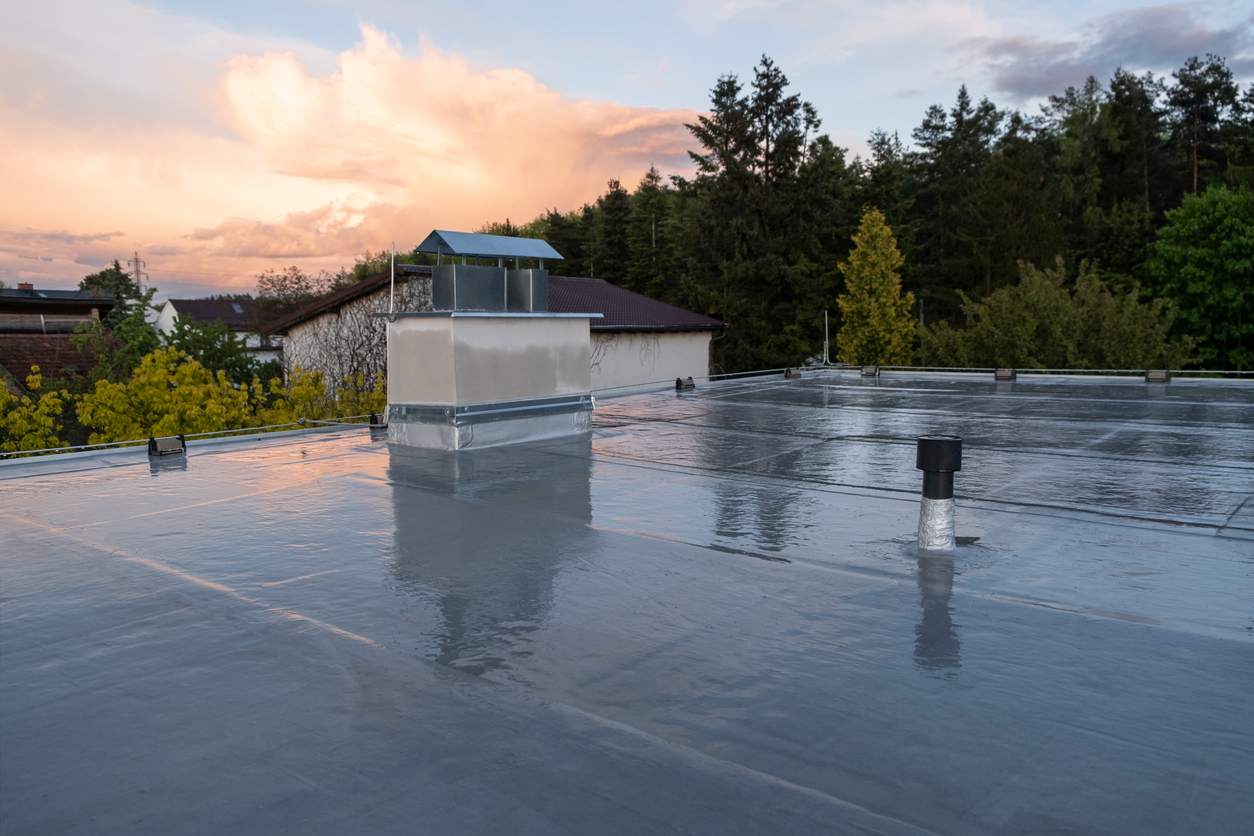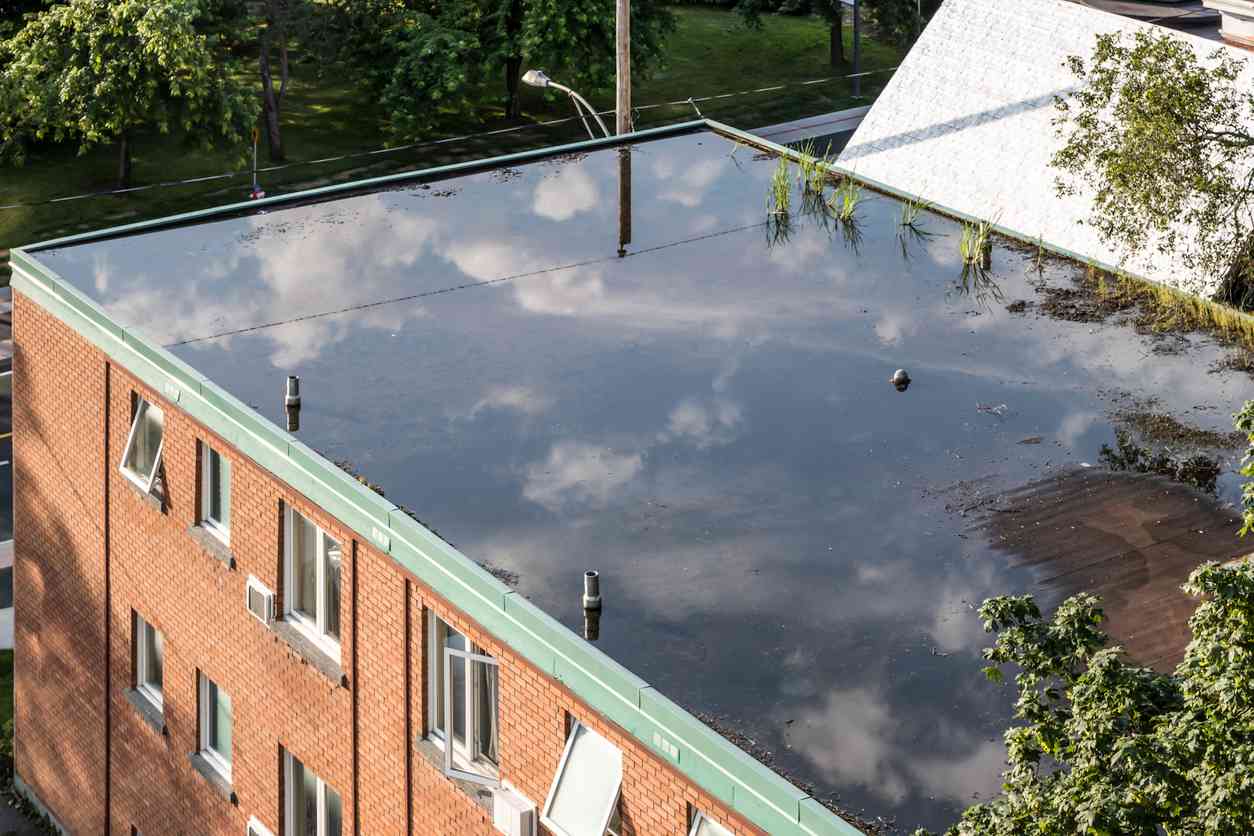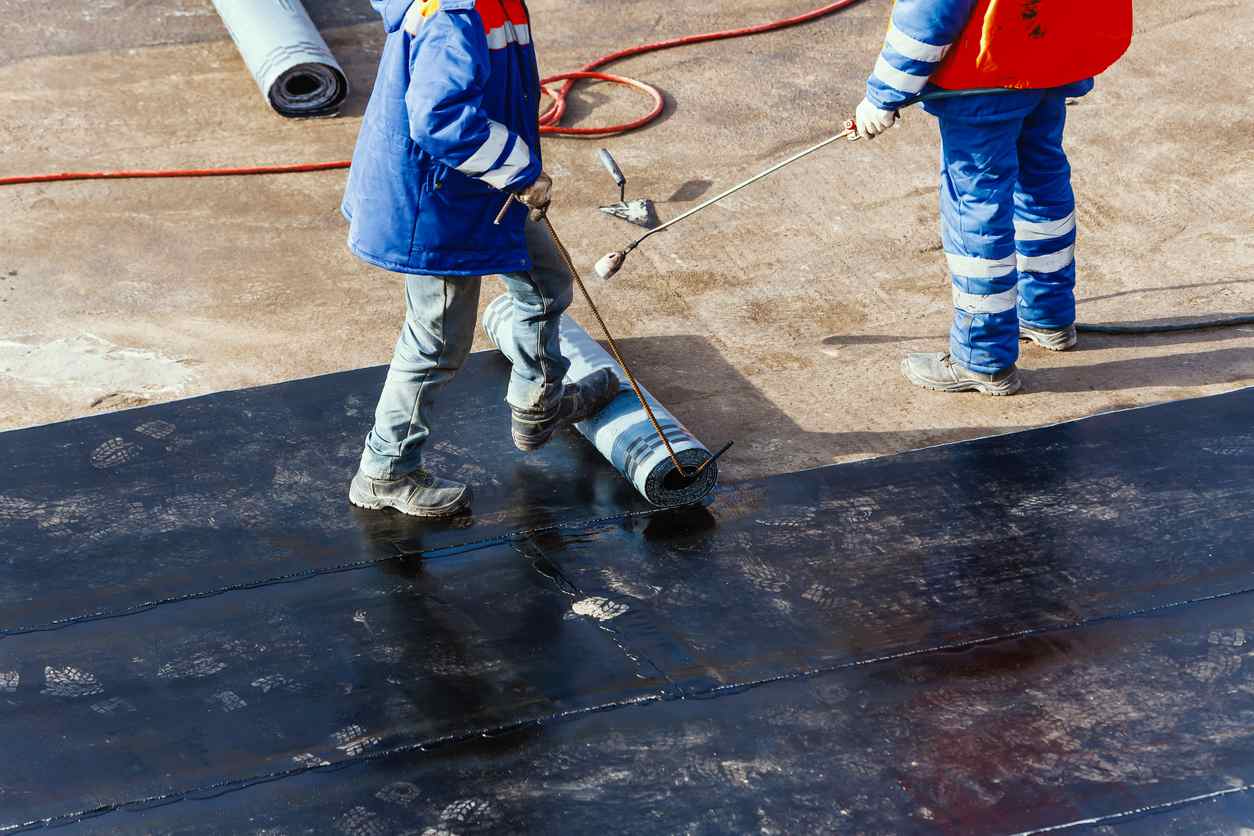
Both commercial and residential structures can have flat roofs, which differ from sloped roofs in performance, appearance, and material. If you own or manage a building with a flat roof, you may wonder, what is the lifespan of a flat roof? This guide has the answer, along with answers to other commonly asked questions and tips to maintain and protect your roofing materials.
Estimated Flat Roof Lifespan
On average, a flat roof has a lifespan of about 20 years. However, factors like roofing materials and maintenance play a role in the roof’s actual lifespan. Some flat roofs can last for decades, particularly when they’re properly maintained.
Another key factor that affects the lifespan of your flat roof is the weather it’s exposed to regularly. A flat roof that faces harsh summer heat and/or freezing winter snow has a shorter lifespan than one in a more temperate location.
Flat Roofing FAQ
We’ve compiled some of the most frequently asked questions about flat roofing and provided detailed answers.
How Often Should You Replace Your Flat Roof?
On average, a flat roof on a residential or commercial structure needs replacement after about 15 years. A roof could have a slightly longer lifespan depending on the roofing materials used and the maintenance schedule followed.
It’s important to monitor the condition of your roof, especially as you get closer to the 15-year point. Contact a flat roofing company for repair or replacement at the first sign of cracking, peeling, or tearing in the roofing materials.
How Long Does a Flat Membrane Roof Last?
An elastomeric bitumen membrane for a flat roof typically lasts around 20-25 years. It could last even longer if a professional installed it and it undergoes regular maintenance.
How Do You Prolong the Life of a Flat Roof?
Being proactive can extend a roof’s lifespan. Here are six tips to prolong the life of your flat roof.
Conduct Frequent Inspections: Flat roofs are durable, but they’re constantly at risk of sustaining damage. Through regular, frequent inspections of your roof, you can spot any warning signs and take proactive measures to help extend the lifespan of your flat roof. If you can inspect your own roof safely, make sure to walk over the entire surface and look at the materials. Materials should provide complete coverage and should never appear fragile, brittle, or cracked.
- Maintain the Drainage System: Flat roofing systems require functional drainage systems to prevent moisture accumulation. If your drains get blocked, the resulting pooling of water is cause for concern and needs immediate attention. Make sure all drains, including their entrances and exits, allow water to flow freely through them.
- Add Guards: Consider adding guards to your drainage system. These coverings can prevent branches, twigs, leaves, and other yard debris from entering the gutters, helping water to drain properly.
- Check for Puddles or Standing Water: Standing water is the kryptonite of any roof, including a flat one. If left untreated, it can lead to rot and damage. Even during the winter, water is dangerous because frozen layers of ice can destroy the roof from the inside out.
- Consider Adding Extra Waterproofing: Some types of flat roofing can benefit from an extra layer of protection. By reinforcing your roof with an extra layer of waterproofing material, you can protect the structure and first layer of roofing materials.
- Stay Mindful of the Environment: Although you can’t control the weather, you can set your roof up for success against Utah’s hot summers and cold winters. Look above the roof for tree branches that may scrape and cause damage. Trimming back branches can prevent severe damage, even if a big storm hits.
Which Roof Covering Has the Longest Life Expectancy?
Of the three main types of flat roofing materials, ethylene propylene diene monomer (EPDM) lasts the longest. The average lifespan of an EPDM roof is between 25 and 30 years. Modified bitumen comes in second with an average lifespan of 12–20 years.
As with all roofs, the lifespan of your flat roof depends on the quality of the installation, maintenance schedule, and weather conditions.
How Often Should a Rubber Roof Be Replaced?
You can expect to replace a rubber roof, or an ethylene propylene diene monomer roof, after about 25 to 35 years. If you’re in an area where the roof faces extreme weather conditions, it may not last quite that long.
Another factor that affects a rubber roof’s lifespan is the quality of the materials used to construct it. Thicker materials generally last longer than thinner or weaker materials.
The best way to determine if your rubber roof needs replacement is to inspect it. If the roofing materials are dry, cracking, or crumbling, it’s time to replace your roof.
You should also look at the seams between the roofing materials. They should be watertight with no visible gaps. If you see small gaps in coverage, it’s also time for a new roof.
 Does House Insurance Cover Flat Roofs?
Does House Insurance Cover Flat Roofs?
Insurance coverage for a flat roof generally mirrors the coverage provided for a pitched roof. Most insurers cover damage caused by severe weather conditions, fires, and other natural disasters. By contrast, normal wear and tear usually aren’t covered under a policy.
If you’re curious about what your insurance policy covers on your flat roof, review the coverage information in detail.
Will a Flat Roof Always Leak?
A flat roof that’s installed and maintained properly won’t leak. If the roof sustains damage, it may allow moisture to enter the space.
One of the biggest problems associated with a flat roof is water damage. A pitched roof relies on gravity for moisture drainage, but a flat roof doesn’t have gravity on its side.
When it’s not installed correctly, water can pool on a flat roof. The longer water stays stagnant on the roof, the higher the risk of damage to the roofing materials, which can lead to a roof leak. The best way to prevent roof leaks and extend your flat roof’s lifespan is to ensure moisture drains properly.
Get Your Flat Roof Installed by the Experts at American Roofing
One common theme you may have noticed in this guide is that the installation process of a flat roof plays a significant role in its functionality and lifespan. Our team at American Roofing specializes in flat roofing, and we have extensive experience in installing, maintaining, and repairing this type of roof. Contact us to learn more about our roofing services or request an estimate.


 Conduct Frequent Inspections: Flat roofs are durable, but they’re constantly at risk of sustaining damage. Through regular, frequent inspections of your roof, you can spot any warning signs and take proactive measures to help extend the lifespan of your flat roof. If you can inspect your own roof safely, make sure to walk over the entire surface and look at the materials. Materials should provide complete coverage and should never appear fragile, brittle, or cracked.
Conduct Frequent Inspections: Flat roofs are durable, but they’re constantly at risk of sustaining damage. Through regular, frequent inspections of your roof, you can spot any warning signs and take proactive measures to help extend the lifespan of your flat roof. If you can inspect your own roof safely, make sure to walk over the entire surface and look at the materials. Materials should provide complete coverage and should never appear fragile, brittle, or cracked. Does House Insurance Cover Flat Roofs?
Does House Insurance Cover Flat Roofs?